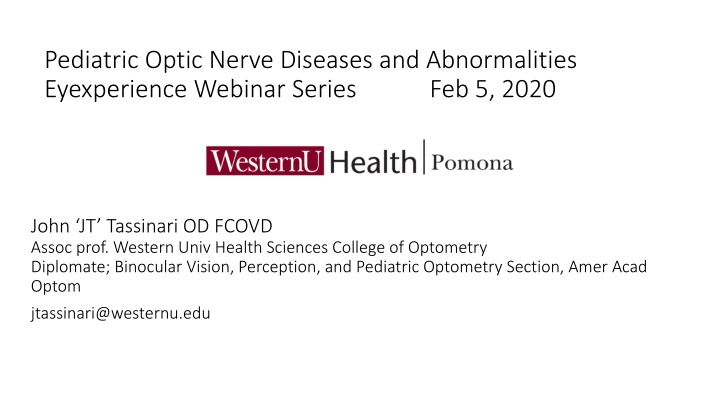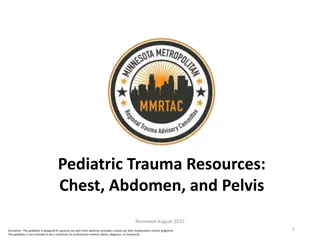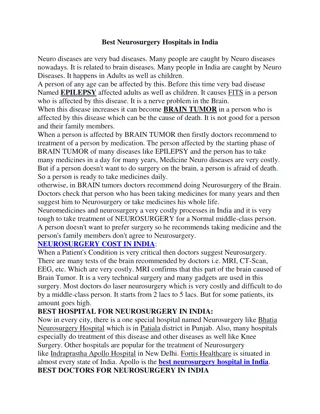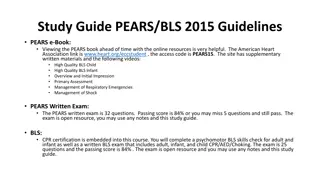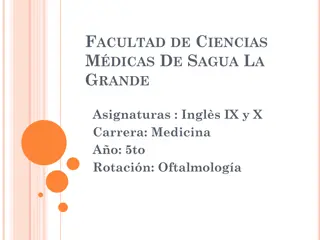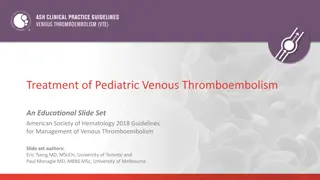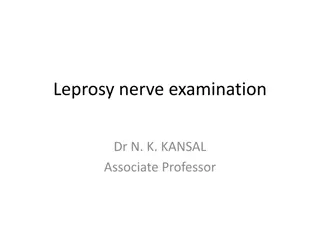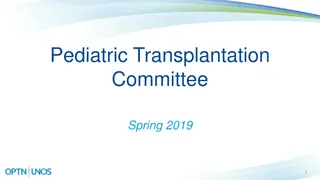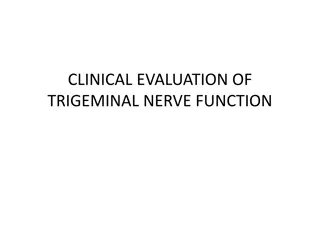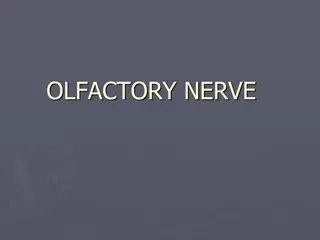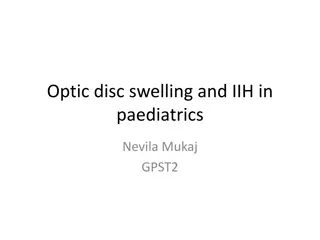Pediatric Optic Nerve Diseases and Abnormalities Webinar
Learn about pediatric optic nerve conditions, developmental anatomy, and testing methods in this informative webinar series presented by Dr. John J.T. Tassinari. Explore topics such as hypoplasia, CD abnormalities, and more. Gain insights into testing techniques for both cooperative and pre-verbal children. Discover the significance of pupil tests in detecting abnormalities like an afferent pupillary defect (APD) in pediatric patients. Enhance your understanding of pediatric optic nerve diseases and abnormalities through this comprehensive webinar series.
Download Presentation

Please find below an Image/Link to download the presentation.
The content on the website is provided AS IS for your information and personal use only. It may not be sold, licensed, or shared on other websites without obtaining consent from the author.If you encounter any issues during the download, it is possible that the publisher has removed the file from their server.
You are allowed to download the files provided on this website for personal or commercial use, subject to the condition that they are used lawfully. All files are the property of their respective owners.
The content on the website is provided AS IS for your information and personal use only. It may not be sold, licensed, or shared on other websites without obtaining consent from the author.
E N D
Presentation Transcript
Pediatric Optic Nerve Diseases and Abnormalities Eyexperience Webinar Series Feb 5, 2020 John JT Tassinari OD FCOVD Assoc prof. Western Univ Health Sciences College of Optometry Diplomate; Binocular Vision, Perception, and Pediatric Optometry Section, Amer Acad Optom jtassinari@westernu.edu
Disclosures No relevant financial relationships to disclose Course material and information was developed without influence from commercial interest The course material and information was developed with some assistance from Dr. Phil Kwok, Dr. Naida Jakirlic, and Dr. Tiffanie Harris.
Course Overview 1. Relevant Developmental Anatomy 2. Pediatric Optic Nerve Tests 3. 9 Pediatric Optic Nerve Conditions Benign (usually) 1. Large CDs 7. Disc Edema 2. Mild hypoplasia 8. Pallor 3. Small full disc 9. Hypoplasia, not mild 4. Buried Optic disc drusen 5. Congenital Tilt 6. Myopic tilt / peripapillary atrophy Disease
(Pediatric) Optic Nerve Tests Direct inspection with ophthalmoscopy (or imaging) Pupil light reactions Monocular VA Monocular color vision Visual fields Contrast sensitivity Light brightness comparison or red cap comparison If child capable of performing these 2, can treat as if an adult.
Optic Nerve Tests, Child Pre-Verbal or uncooperative Direct inspection with ophthalmoscopy (or imaging) Pupil Light Reactions Not always. May need to use swinging hand method Monocular VA ..maybe Monocular color vision Visual fields Contrast sensitivity Light brightness or red cap comparison
Pupil test for + APD Swinging Hand Pediatric method Observe pupils in normal room illumination. Note diameters Cover 1 eye (Parent covers with hand? Peek a boo ) Uncovered eye unchanged or slight pupil dilation Uncovered eye dilates noticeably (and more than fellow eye) No APD for that eye + APD for that eye
Relevant Developmental Anatomy In utero, nerve fiber redundancy. Controlled apoptosis begins at ~ 4 mos gestation and ends at 7-8 mos gestation, 3.7 million reduces to 1.1 million axons Disease maldevelopment can cause fewer axons at age 4 mos: Hypoplasia If apoptosis ignores stop signal, hypoplasia Disc and nerve are 75% of adult size at birth. 95% of adult size at age 1 year. Smaller than avg disc may be hypoplasia Scleral canal anatomy: Its anterior end dictates size of optic disc and thereby the cup and thereby the C to D ratio.
Optic Nerve Hypoplasia Due to reduced number of optic nerve fibers at birth Bilateral or Unilateral Can range from inconsequential/mild to severe with lifelong poor vision Bilateral Endocrine and cerebral maldevelopment concerns Unless mild, lifelong vision impairment Unilateral Less concern about endocrine and CNS disease Mild Unilateral = Relative Hypoplasia = Very Common
Bilateral Optic Nerve Hypoplasia (ONH) Risk Factors: First parity, young maternal age, maternal smoking and ETOH, preterm birth, low birthweight, low APGAR, C-Section Range of severity Mild w/ Normal V Severe w/ Blindness Comorbidities: Cerebral abnormalities (septum pellucidum). Linked to severity of ONH Endocrine: Hypopituitary with abnormally low growth hormone Hypopituitary not as strongly linked to severity of ONH Tornqvist K. Optic nerve hypoplasia: Risk factors and epidemiology. Acta Ophthal 2002
Bilateral Optic Nerve Hypoplasia. Fundus findings 1. Small disc (always). Area of disc compared to size of overlying BVs 2. BVs: tortuosity or uncommonly straight with < normal branching points 3. Double ring sign (Do not need #2 and #3) There is a very wide variation in the appearance and effects of hypoplastic optic discs, all of which are best seen with high magnification using the direct ophthalmoscope Taylor DS. Congenital anomalies of the optic discs. Pediatric Ophthalmology and Strabismus 5th ed. 2017
Case Report: KG, Small baby w small optic discs Well V Exam, InfantSEE. No concerns 3 older siblings Age 7 mos. KG looks small /younger (age 4-5 mos) Normal eye contact and good visually guided reaching ~10th %ile L and W. Pediatrician / Parents unconcerned Brief BIO and Direct o scope views: optic discs appear small. Disc color, peripap retina and BVs look normal Exam o/w normal, incl visual function Cyclo +1.50 -0.50 180 Ret +1.50 -0.50 180
KG, age 7 mos. Small baby w small optic discs A: Small optic discs with small stature. Needs r/o of true bilateral optic nerve hypoplasia P: Refer to pediatrician, advise r/o of low growth hormone Outcome: Pediatrician referred to Ped OMD and Ped endocrinologist Mild bilateral O N Hypoplasia confirmed. Vision normal (at last report) + reduced GH. Supplemental Growth hormone prescribed Stewart et al. International Journal of Pediatric Endocrinology 2016:5
Severe unilateral hypoplasia Case Report AH, age 8;7. Recent immigrant. Referred for VT consultation Low normal birth weight. Mom was young at his birth Now: Normal size, normal development, academic progress good BCVAS: 20/20 OD 20/400 OS. Constant Left Exotropia. XT onset: age 2 3 years Abnormal color vision and + APD OS Poor vision and exotropia (XT) were caused by severe optic nerve hypoplasia OS
Mild unilateral hypoplasia Smaller, hypoplastic nerve has smaller cup COMMON, ALL AGES J Amer Optom Assoc 1987 58 (6)
Relative Hypoplasia of the Optic Nerve Key clinical relevance is that the normal size nerve will have a bigger cup and thereby mimic glaucomatous cupping in that eye Perceived difference in brightness is somewhat common Side by side comparison of fundus photos is best way to diagnose
Relevant Developmental Anatomy(cont.) In utero: Controlled apoptosis Normal growth of optic nerve Scleral canal anatomy A. Anterior end dictates size of optic disc B. Size of disc dictates size of cup A + B = C to D ratio No of axons passing through: Somewhat, but not completely, independent of scleral canal size. Smaller disc fewer axons Optic nerve insertion into globe ,if anomalous (oblique), can cause congenital tilted optic disc tilt syndrome Jonas JB. Human Optic Nerve Fiber Count and Optic Disc Size Investigative Ophthalmology & Visual Science 1992
Bilateral Large CD Ratios in a Child Almost always due to a large disc, not death of axons glaucoma Large discs result from anatomical variation of the scleral canal. Physiologic cupping (anatomical cupping) Low pressure glaucoma does not occur in children True Juvenile Glaucoma is always due to elevated IOP
Juvenile Glaucoma Typical onset is late childhood up to age 35 years Strong FHx, Autosomal Dominant Open angle High IOPs in an otherwise healthy, normally developing (developed) child, teen, or young adult Not to be confused with primary congenital glaucoma (1) Onset first year of life. Bilateral but can be asymmetric (2) Presents with lacrimation, blepharospasm, photophobia, and inconsolable crying (3) Buphthalmos: Cornea edema and enlarged corneae
Bilateral Large CDs Case Report. JM age 3;2. Hispanic Boy (Medi-Cal) At age 2;6 Pediatrician observes large CDs during ophthalmoscopy. Refers to ophthalmologist to r/o glaucoma Ophthalmologist (no IOP performed) refers back to pediatrician and requests referral to children s hospital for EUA Referral becomes confusing, complicated, and lengthy Family brings child to Eye Care Institute and pleads for help
JM age 3;2. Uncooperative Hispanic Boy Exam Results Unable to occlude for any monocular tests No strab. Pupils Normal Retinoscopy: low CHA. + Large CDs 0.7 round OD / OS Discs look larger than average size IOPs: determined to be normal per tonopen with extraordinary restraint of child Can t be primary congenital glaucoma. He is very young for true juvenile glaucoma
Routine IOP Testing, Child AOA EVIDENCE-BASED CLINICAL PRACTICE GUIDELINE. COMPREHENSIVE PEDIATRIC EYE AND VISION EXAMINATION. 2017 Measurement of Intraocular Pressure Measuring intraocular pressure (IOP) is a part of the comprehensive pediatric eye and vision examination. Although the prevalence of glaucoma is low in children, measurement of IOP should be attempted. Pressure should be assessed when ocular signs and symptoms or risk factors for glaucoma exist. If risk factors are present and reliable assessment of IOP under standard clinical conditions is impossible, testing under anesthesia may be indicated. Recording of tonometry results should include method used and time of day. (Evidence Grade: C)
Routine IOP Testing, Child Amer Acad Opthalmol Preferred Practice Pattern 2017 Intraocular Pressure Measurement Intraocular pressure measurement is not necessary for every child because glaucoma is rare in this age group and, when present, usually has additional manifestations (e.g., buphthalmos, epiphora, photosensitivity, and corneal clouding in infants; enlarged optic cups in older children; and myopic progression in very young children). Intraocular pressure should be measured whenever a child has or is at risk for glaucoma.
Optic Nerve Tests re-visited. Direct ophthalmoscopy to see spontaneous venous pulsation Best seen with direct ophthalmoscope Spontaneous retinal venous pulsations (SVPs) are rhythmic variations in the caliber of one or more of the retinal veins as they cross the optic disc. SVPs may be subtle and are often limited to a small segment of only one vein. Whether they are obvious or difficult to identify, their appearance is that of a rhythmic movement of the vessel wall in time with the cardiac cycle narrowing with systole and more rapid dilation with diastole. The presence of a SVP rules out true disc edema (almost always, rare exceptions) Its absence does NOT = true disc edema
Choked Swollen appearance to a childs optic disc (s) Small scleral canal with small crowded disc Buried Optic Disc Drusen Congenital tilted discs with elevation of nasal disc and blurred disc margins PSUEDO papilledema True disc swelling due to optic neuritis (almost always 1 eye) True disc swelling due to elevated ICP = Papilledema Papilledema may be due to cranial mass, psuedotumor cerebri, or other neurologic disease
Swollen Appearance to Optic Disc(s), Child Present OU Papilledema due to cranial mass? Present in one eye only True optic neuritis Symptoms: blur and pain with eye movement Neurological symptoms ? ABSENT PRESENT REFER Don t Refer
Swollen Appearance to Optic Disc(s), Child Present in one eye only Present OU True Papilledema Possible Symptoms True optic neuritis PRESENT: HA s upon awakening TVOs. Worse w/ bending or Valsalva Acquired strabismus with diplopia Nausea Vomiting Gait disturbances ABSENT: Inconclusive VA normal unless macular edema
True Disc Swelling Extends beyond disc margin Obscured at disc margins Present Psuedo Elevation Disc BVs Venous congestion Exudates Hemes Confined to disc Visible at margin Absent No exudates. Hemes possible with drusen Small or absent if pseudo is due to small discs Possible If normal size disc, obscured only in moderate to severe swelling Absent Cup SVP Present or absent No unless advanced O Disc Drusen Retinal & Choroidal Folds Possible
Small Crowded Discs Scleral canal, esp anterior opening at the level of Bruchs membrane, is small. Therefore, Optic Disc is small. BVs, glial tissue and vasculature crowd into smaller space (Very) Small C to D ratio. Cupless disc possible SVP expected to be present Associated with Hyperopia but not exclusively Check family members At risk for optic disc drusen Can mimic true disc swelling. AKA psuedopapilledema
Buried Optic Disc Drusen Refractile bodies composed primarily of calcium deposited anterior to Lamina Cribosa Occur in small, crowded optic nerve heads. Propensity to locate nasal in disc Pathogenesis: Abnormal ganglion cell axon metabolism (1) abnormal vasculature (2) narrow scleral canal May displace neuroretinal rim tissue anteriorly causing a false appearance of nerve swelling Become more visible with age Most common cause of psuedopapilledema Usually asymptomatic Buried drusen (can t see) versus surface drusen (obvious yellowish rock candy ) Fundus autoflourescence or B scan ultrasonography can diagnose Lam BL et. al. Drusen of the optic disc. Current Neurology 2008: 8; 404-408
Complications of Optic Disc Drusen: Buried or Surface Optic disc and retinal hemorrhage Anterior ischemic optic neuropathy (AION, non-arteritic) Central retinal artery occlusion Central retinal vein occlusion Peripapillary choroidal neovascularization Vision Loss / VF defects: rare in children. Possible later in life All are uncommon. Most patients with O Disc Drusen do not have active disease or symptoms
DA, age 13. VT symptoms despite SRx -0.50 - .25 180 20/20 + -1.50 - .75 180 20/20+ Mild HAs & variable near blur getting better PMH: overweight, no meds No strab. EOMs (no pain) & pupils normal VFs & Color V normal Accommodative & vergence work-up: Normal Elevated discs with blurred margins observed with D O
DA, age 13. VT symptoms despite SRx VT related symptoms gone. Needed time to adjust to new SRx. No VT needed Elevated discs with blurred margins observed with D O Case history suggests elevation and margin blur were acquired over the past month. Also has headaches (mild, variable) Age and appearance (small discs, nasal elevation) suggest buried drusen Referral results in full neuro eval. B scan confirms optic disc drusen
Congenital Tilted Optic Disc Odd appearance to the optic disc. Optic nerve enters eye at an oblique angle. Top down view of OS Fovea V V OS: Normal angle of insertion Oblique angle of insertion
Congenital Tilted Optic Disc Odd appearance to the optic disc because of optic nerve enters eye at an oblique angle. Bilateral (common) or unilateral Nasal disc margin (usually) is elevated and obscured: may mimic swollen disc. If OU, may mimic papilledema Full Syndrome: Tilt, Torsion, marked peripap atrophy (or staphyloma), situs inversus Associated with CMA May cause VF defects that mimic glaucoma or incomplete bitemporal hemianopsia. Complicates disc RNFL in glaucoma There are exceptions to the tilt direction Not to be confused with acquired myopic tilt
Tilted optic disc with Torsion. Macula is more inferior Normal Disc macula geography
Congenital tilted disc *Nasal margin (esp superonasal) elevated and blurred *PPA present on temporal side *Increased ovality *No torsion
True Papilledema, Pediatric Bilateral disc swelling secondary to elevated intracranial pressure Space occupying cranial mass may be etiology Idiopathic intracranial hypertension (IIH) aka pseudotumor cerebri does occur in children VA normal unless secondary macular pathology
True Papilledema. Case Report. NP Age 13 years Dysmenorrhea diagnosis leads to Rx oral contraceptives. July 2018 1 week later: Develops significant H As with blurry vision. Begins care with neurologist 1 month later: Headaches persist / worsen and are joined by blurry vision (TVOs). NP is examined at ECI (1)True bilateral disc swelling diagnosed. Presumed papilledema (2)+VF defects, reduced VA, +RAPD OS (color v normal) (3)Retina / macular edema (4)Plan: Same day referral to neurologist
True Papilledema. Case Report. NP Age 13 years (cont.) Neurologist performs ophthalmoscopy and disagrees with swollen discs diagnosis 6 weeks later. Neurologist subtracts BCP and adds Topiramate for HA relief. Takes Topiramate for approx. 2 months (Aug Oct 2018) Papilledema resolves Oct 2018. Lumbar puncture not performed because neurologist disagreed with papilledema diagnosis. When finally performed, NP had taken topiramate (and D/C BCP) for 5 weeks. It is normal
Pediatric Optic Neuritis True Swelling of Disc. Monocular Common causes in a healthy child: post febrile illness, post vaccination Optic neuritis in a young / preverbal child is expected to go unreported by child Eye doctors see pallor later Almost all pediatric optic neuritis includes disc swelling (adults, retro bulbar is common)
DS, age 6;4 Failed vision screening at pre-school (age 5) Pediatric OMD diagnosed anisometropic amblyopia LEFT eye Treatment: SRx full time and part time direct occlusion of OD .. Minimal improvement Cc: Will VT help? Compliant with SRx . Poor compliance with occlusion Exam poor BCVA OS confirmed (20/60) 3.50D anisometropia confirmed
DS, age 6;4 Exam (cont.) Unaided VA D OD 20/20 OS 20/100 RS60 N (40cm) RS20 Consistent with myopia OS Subj +1.75 -.25 180 20/20 -1.75 -.25 180 20/60
DS, age 6;4 Amblyopia (?) Left Eye Sensory Fusion: Suppress OS No random dot stereo + Gross Stereo (fly) Cover Test: No strab Pupils normal EOMs full Color Vision: OD normal OS abnormal (slow) Visual Fields OD normal OS abnormal Ophthalmoscopy: OS disc is pale. Inferior RNFL gone Diagnosis: Post optic neuritis optic atrophy. Optic neuritis is unknown etiology. Vision loss from O Neuritis triggered axial elongation causing anisometropia
DG age 7. Referred for VT Work-Up for amblyopia 20/60 BCVA OS No strabismus No aniso + Color vision loss OS + APD OS OS: Pale disc NO AMBLYOPIA
DG age 7. Pallor OS due to Anterior Optic Nerve Glioma Retrobulbar astrocytic fibrous tumor Nerve compression inflammation (optic neuritis) time pallor Clinical signs: VA, R/G color, VF defects, + APD NON-metastatic. May or may not be treated Posterior glioma: Located in chiasm. neurofibromatosis
Acquired Myopic Tilt with Parapapillary Atrophy Acquired and progresses as eye elongates. Scleral stretching causes tilt and development / enlargement of parapapillary atrophy Not to be confused with congenital tilted disc syndrome secondary to oblique insertion Generally benign adds complexity / risk to adult glaucoma analysis Myopes with Tilt & PPA have greater myopic progression than myopes w/o Tilt & PPA Long-Term Changes in Refractive Error in Children With Myopic Tilted Optic Disc Compared to Children Without Tilted Optic Disc. Park K-A IOVS 2013 Kim T-W. Optic Disc Change with Incipient Myopia of Childhood Ophthalmology 2012
Nakazawa M, et. al. Long-term findings in peripapillary crescentt formation in eyes with mild or moderate myopia. Acta Ophthalmologica 2008
OD Optic Disc at baseline 3 years later. Significant Myopic Increase Optic disc change with incipient myopia of childhood. Ophthlamology 2012; 119: 21-26
Patient B. Progressive Myopia with Smaller than avg O Disc. Baseline 3 years later.
Characteristics and appearance of the normal optic nerve head in 6-year-old children Samarawickrama C et. al. Br J Ophthalmol 2012;96 Hyperopic eyes with parapapillary atrophy (PPA) were longer than hyperopic eyes without parapapillary atrophy PPA: a possible pre-myopic risk factor
